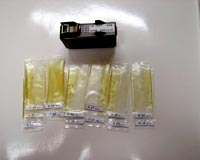 |
Bangalore, India (SPX) Jul 27, 2009 The intense radiation from the sun that roasted India's first unmanned lunar satellite's key orientation instrument - the star sensor - has raised concerns over the safety of Indian astronauts on the country's first manned space flight, planned around 2015. A scientist from the Indian Space Research Organisation (ISRO) pointed out that radiation can kill astronauts if the emissions from the sun are intense. Scientists at ISRO are taking no chances. Chandrayaan programme director M Annadurai told DNA that they are looking at "increasing the thickness of the radiation shield for Chandrayaan-II." The star sensor failure has forced them to rework their design. The improvised radiation shield will protect the next unmanned moon mission, Chandrayaan-II, scheduled for 2012-13. ISRO scientists say the shield for Chandrayaan-II will be a tester for the manned space flight. ISRO wants to send two Indian astronauts for about a week into an earth orbit. As an indication of how deadly the blasts of radiation can be, the education and outreach programme of NASA's Radiation Belt Modelling for Living With a Star narrates: "A major flare that occurred half way between the Apollo 16 and Apollo 17 moonwalks, would have had a much more deadly outcome had it arrived while astronauts were outside their spacecraft (on the moon) playing golf. Within a few minutes, the astronauts would have been killed on the spot with an incredible blast of radiation." Scientists plan to land a robotic rover that will explore the lunar surface in their Chandrayaan-II mission. They are now awaiting the conclusion of ISRO's review meeting to take stock of the Chandrayaan-I mission, including the failure of the star sensors, which will be held later this year. Annadurai admitted that since this was the first time that India had sent a satellite into a close lunar orbit at an altitude of just 100 kms, "we have learnt from our experience that we need to improve the radiation shield for the next mission." At a distance of just 100km from the moon's surface, any lunar satellite receives an overdose of radiation - primarily the direct blasts from the sun, and secondarily, the reflected radiation off the moon's surface. One of the avenues before space scientists while dealing with high radiation threatening satellites is to completely close down the satellite's operations. "But we cannot close down the star sensor as that would mean losing the orientation of the satellite, which is difficult to regain later," said Annadurai. The star sensors keep the satellite pointed in a particular direction. This is a key instrument for satellites that can help the camera side pointed at the earth's or moon's surface. Share This Article With Planet Earth
Related Links Indian Space Research Organisation (ISRO) Space Tourism, Space Transport and Space Exploration News
 Roundworms Could Pioneer Space For Human Astronauts
Roundworms Could Pioneer Space For Human AstronautsMoffett Field CA (SPX) Jul 10, 2009 A transparent roundworm could reveal the biological effects of microgravity and space radiation, and perhaps provide clues on how to protect future human astronauts headed for the moon, Mars and beyond. The C. elegans worm's biological responses proved eerily similar to those of humans during a series of experiments aboard the International Space Station in 2004. Now researchers have ... read more |
|
| The content herein, unless otherwise known to be public domain, are Copyright 1995-2009 - SpaceDaily. AFP and UPI Wire Stories are copyright Agence France-Presse and United Press International. ESA Portal Reports are copyright European Space Agency. All NASA sourced material is public domain. Additional copyrights may apply in whole or part to other bona fide parties. Advertising does not imply endorsement,agreement or approval of any opinions, statements or information provided by SpaceDaily on any Web page published or hosted by SpaceDaily. Privacy Statement |